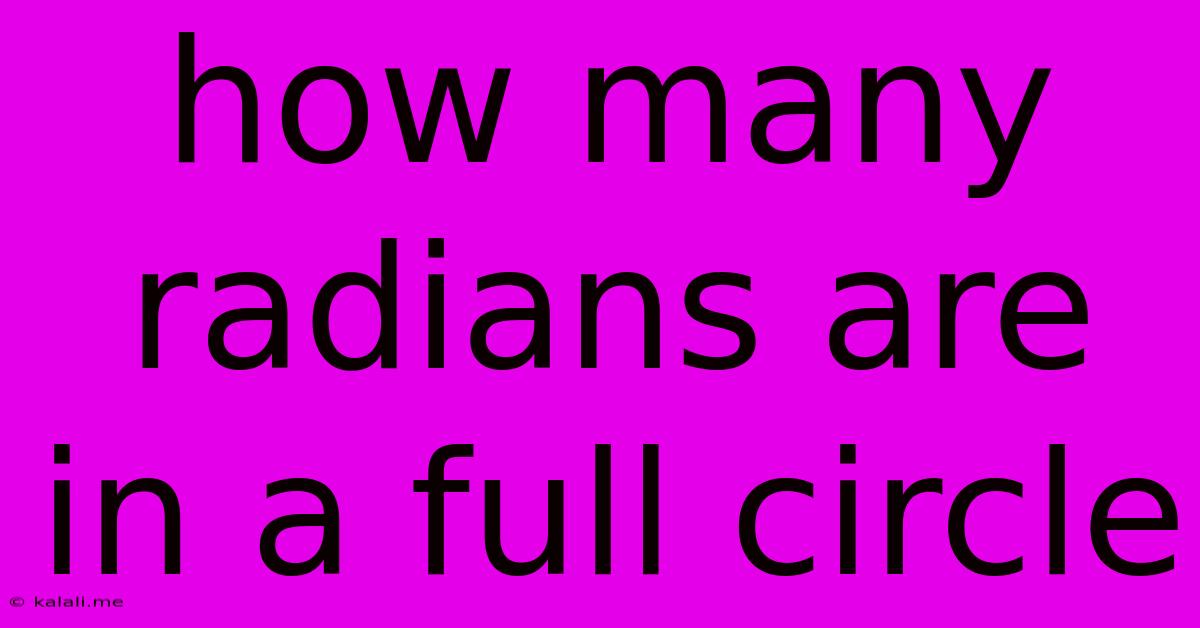How Many Radians Are In A Full Circle
Kalali
May 09, 2025 · 2 min read

Table of Contents
How Many Radians are in a Full Circle? Understanding Radian Measure
Radians are a unit of measurement for angles, offering a more natural and mathematically convenient way to express angles compared to degrees. Understanding radians is crucial in various fields, including trigonometry, calculus, and physics. This article will explore the fundamental relationship between radians and a full circle, explaining why there are 2π radians in a 360-degree circle.
What is a Radian?
A radian is defined as the angle subtended at the center of a circle by an arc whose length is equal to the radius of the circle. Imagine a circle with radius 'r'. If you take an arc along the circumference of the same length 'r', the angle formed at the center by this arc is one radian.
Deriving 2π Radians in a Full Circle
The circumference of a circle is given by the formula C = 2πr, where 'r' is the radius. Since a radian is defined by an arc length equal to the radius, we can determine how many radians make up a full circle by dividing the circumference by the radius:
C/r = (2πr)/r = 2π
Therefore, there are 2π radians in a full circle.
Why Radians are Important
The use of radians simplifies many mathematical operations, particularly in calculus and trigonometry. Several key reasons highlight their importance:
-
Simplicity in Calculus: Many calculus formulas involving trigonometric functions are significantly simplified when using radians. Derivatives and integrals of trigonometric functions have much cleaner expressions in radians. For instance, the derivative of sin(x) is cos(x) only when x is measured in radians.
-
Natural Relationship with Circle's Geometry: The definition of a radian directly relates the angle to the circle's geometry through its radius and arc length, making it inherently more intuitive for certain calculations.
-
Unitless Nature: While radians are a unit of measurement, they are often considered "unitless" in calculations because the ratio of arc length to radius cancels out the units. This makes it easier to incorporate radians into complex equations without unit conversion issues.
Converting Degrees to Radians and Vice Versa
Since we know there are 360 degrees in a full circle and 2π radians in a full circle, we can establish conversion factors:
-
Degrees to Radians: Multiply the angle in degrees by (π/180)
-
Radians to Degrees: Multiply the angle in radians by (180/π)
Understanding Radian Measure: A Summary
In summary, the number of radians in a full circle is 2π. This fundamental relationship stems from the definition of a radian and the circumference of a circle. Understanding radians is essential for anyone working with angles, particularly in higher-level mathematics and physics, due to their mathematical elegance and inherent connection to the geometry of the circle. The use of radians simplifies numerous calculations and provides a more natural representation of angles compared to degrees.
Latest Posts
Latest Posts
-
What Is 4 Percent Of 16
May 09, 2025
-
What Percent Is 14 Out Of 16
May 09, 2025
-
14 Is What Percent Of 20
May 09, 2025
-
How Much Is 123 Seconds In Minutes
May 09, 2025
-
Cuanto Es 19 Farenheit A Centigrados
May 09, 2025
Related Post
Thank you for visiting our website which covers about How Many Radians Are In A Full Circle . We hope the information provided has been useful to you. Feel free to contact us if you have any questions or need further assistance. See you next time and don't miss to bookmark.